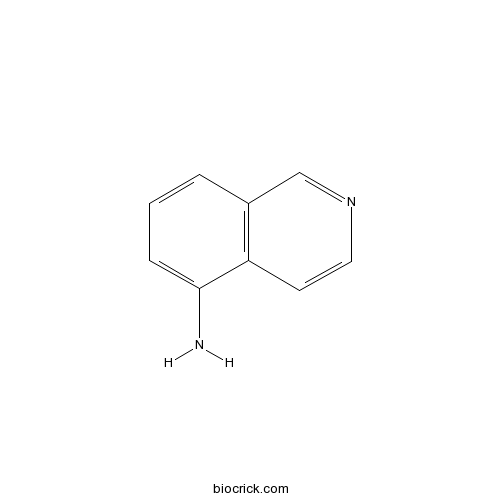5-AminoisoquinolineCAS# 1125-60-6 |

Quality Control & MSDS
3D structure
Package In Stock
Number of papers citing our products

| Cas No. | 1125-60-6 | SDF | Download SDF |
| PubChem ID | 70766 | Appearance | Powder |
| Formula | C9H8N2 | M.Wt | 144 |
| Type of Compound | N/A | Storage | Desiccate at -20°C |
| Solubility | Soluble in Chloroform,Dichloromethane,Ethyl Acetate,DMSO,Acetone,etc. | ||
| Chemical Name | isoquinolin-5-amine | ||
| SMILES | C1=CC2=C(C=CN=C2)C(=C1)N | ||
| Standard InChIKey | DTVYNUOOZIKEEX-UHFFFAOYSA-N | ||
| Standard InChI | InChI=1S/C9H8N2/c10-9-3-1-2-7-6-11-5-4-8(7)9/h1-6H,10H2 | ||
| General tips | For obtaining a higher solubility , please warm the tube at 37 ℃ and shake it in the ultrasonic bath for a while.Stock solution can be stored below -20℃ for several months. We recommend that you prepare and use the solution on the same day. However, if the test schedule requires, the stock solutions can be prepared in advance, and the stock solution must be sealed and stored below -20℃. In general, the stock solution can be kept for several months. Before use, we recommend that you leave the vial at room temperature for at least an hour before opening it. |
||
| About Packaging | 1. The packaging of the product may be reversed during transportation, cause the high purity compounds to adhere to the neck or cap of the vial.Take the vail out of its packaging and shake gently until the compounds fall to the bottom of the vial. 2. For liquid products, please centrifuge at 500xg to gather the liquid to the bottom of the vial. 3. Try to avoid loss or contamination during the experiment. |
||
| Shipping Condition | Packaging according to customer requirements(5mg, 10mg, 20mg and more). Ship via FedEx, DHL, UPS, EMS or other couriers with RT, or blue ice upon request. | ||

5-Aminoisoquinoline Dilution Calculator

5-Aminoisoquinoline Molarity Calculator
| 1 mg | 5 mg | 10 mg | 20 mg | 25 mg | |
| 1 mM | 6.9444 mL | 34.7222 mL | 69.4444 mL | 138.8889 mL | 173.6111 mL |
| 5 mM | 1.3889 mL | 6.9444 mL | 13.8889 mL | 27.7778 mL | 34.7222 mL |
| 10 mM | 0.6944 mL | 3.4722 mL | 6.9444 mL | 13.8889 mL | 17.3611 mL |
| 50 mM | 0.1389 mL | 0.6944 mL | 1.3889 mL | 2.7778 mL | 3.4722 mL |
| 100 mM | 0.0694 mL | 0.3472 mL | 0.6944 mL | 1.3889 mL | 1.7361 mL |
| * Note: If you are in the process of experiment, it's necessary to make the dilution ratios of the samples. The dilution data above is only for reference. Normally, it's can get a better solubility within lower of Concentrations. | |||||

Calcutta University

University of Minnesota

University of Maryland School of Medicine

University of Illinois at Chicago

The Ohio State University

University of Zurich

Harvard University

Colorado State University

Auburn University

Yale University

Worcester Polytechnic Institute

Washington State University

Stanford University

University of Leipzig

Universidade da Beira Interior

The Institute of Cancer Research

Heidelberg University

University of Amsterdam

University of Auckland

TsingHua University

The University of Michigan

Miami University

DRURY University

Jilin University

Fudan University

Wuhan University

Sun Yat-sen University

Universite de Paris

Deemed University

Auckland University

The University of Tokyo

Korea University
- 4,4-Pentamethylenepiperidine hydrochloride
Catalog No.:BCC6059
CAS No.:1125-01-5
- H-Glu(OcHex)-OH
Catalog No.:BCC2929
CAS No.:112471-82-6
- U-54494A hydrochloride
Catalog No.:BCC6668
CAS No.:112465-94-8
- 3-Phenyl-1-(pyrrol-1-yl)propan-1-one
Catalog No.:BCN4005
CAS No.:112448-69-8
- AZ3146
Catalog No.:BCC3731
CAS No.:1124329-14-1
- Ganoderic acid Jb
Catalog No.:BCN7972
CAS No.:112430-68-9
- Ganoderic acid T-Q
Catalog No.:BCN3209
CAS No.:112430-66-7
- Ganoderic acid TN
Catalog No.:BCN2443
CAS No.:112430-64-5
- 2',5,7-Trihydroxy-8-methoxyflavanone
Catalog No.:BCN6004
CAS No.:112408-71-6
- 3'-Deoxy-4-O-methylsappanol
Catalog No.:BCN3675
CAS No.:112408-68-1
- 3-Deoxysappanchalcone
Catalog No.:BCN3736
CAS No.:112408-67-0
- Tetramethylpyrazine
Catalog No.:BCN1008
CAS No.:1124-11-4
- 6-Aldehydo-isoophiopogonone A
Catalog No.:BCN6629
CAS No.:112500-90-0
- Aristolactam FI
Catalog No.:BCN6005
CAS No.:112501-42-5
- Picrasidine S
Catalog No.:BCN6006
CAS No.:112503-87-4
- Absouline
Catalog No.:BCN1954
CAS No.:112513-33-4
- Isoabsouline
Catalog No.:BCN1955
CAS No.:112513-34-5
- Neolinine
Catalog No.:BCN6564
CAS No.:112515-37-4
- Tubuloside A
Catalog No.:BCN2806
CAS No.:112516-05-9
- Citrusinol
Catalog No.:BCN8083
CAS No.:112516-43-5
- CI994 (Tacedinaline)
Catalog No.:BCC2159
CAS No.:112522-64-2
- ent-16alpha,17-Dihydroxyatisan-3-one
Catalog No.:BCN6607
CAS No.:112523-91-8
- Pioglitazone HCl
Catalog No.:BCC2278
CAS No.:112529-15-4
- 4-O-Methylepisappanol
Catalog No.:BCN3674
CAS No.:112529-37-0
Possible role of poly(ADP-ribose) polymerase in pathological and physiological cardiac hypertrophy.[Pubmed:17235412]
Methods Find Exp Clin Pharmacol. 2006 Dec;28(10):683-9.
The present study was designed to investigate the effect of 5-Aminoisoquinoline, a specific poly(ADP-ribose) polymerase (PARP) inhibitor, in partial abdominal aortic constriction (PAAC) for 4 weeks it induced pathological and chronic swimming training (CST) for 8 weeks it induced physiological cardiac hypertrophy. 5-Aminoisoquinoline (0.3 mg/kg/day and 3 mg/kg/day, i.p.) treatment was started 3 days before PAAC and CST, and it was continued for 4 weeks after PAAC and 8 weeks after initiation of CST. The left ventricular (LV) function and LV hypertrophy were assessed by measuring LVDP, dp/dtmax, dp/dtmin, ratio of LV weight to body weight (LVW/BW), LV wall thickness (LVWT), LV collagen content, LV protein content, and LV RNA concentration. Further, venous pressure (VP) and mean arterial blood pressure (MABP) were recorded. The PAAC, but not CST, produced LV dysfunction by decreasing LVDP, dp/dtmax, dp/dtmin, and increasing LV collagen content. Further, PAAC and CST were noted to produce LV hypertrophy by increasing LVW/BW, LVWT, LV protein content, and LV RNA concentration. Moreover, in contrast to CST, PAAC significantly increased VP and MABP. The 5-Aminoisoquinoline, a potent selective inhibitor of PARP, significantly attenuated PAAC-induced LV dysfunction, LV hypertrophy, increase in VP and MABP. On the other hand, treatment with 5-Aminoisoquinoline did not modulate CST-induced physiological cardiac hypertrophy. These results implicate PARP in PAAC-induced LV dysfunction and pathological cardiac hypertrophy. However, PARP may not be involved in CST-induced physiological cardiac hypertrophy.


